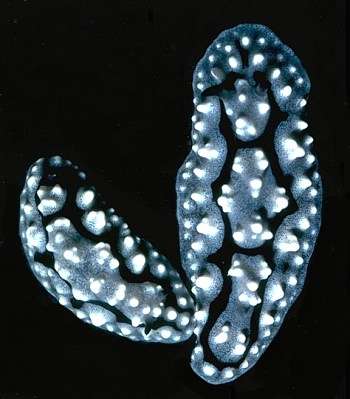
Phyllidiella granulata
Brunckhorst, 1993
Order: NUDIBRANCHIA
Suborder: DORIDINA
Superfamily: EUDORIDOIDEA
Family: Phyllidiidae
DISTRIBUTION
Known from the tropical western Pacific Ocean (Micronesia to the Great Barrier Reef, Australia).
PHOTO
18 m depth, Bile Bay, Guam, 29 June 1988, Dorsal view of 20 and 29 mm specimens (Brunckhorst, 1993: Plate 7A).
Notes compiled from Brunckhorst, 1993:
The distinguishing external features of P. granulata are the grey background with conical and acute compound white tubercles, and the circular black bands medially. The granular white pattern on the grey foot sole of live specimens is also characteristic. Phyllidiella granulata possesses fewer lamellae on the rhinophoral clavus than most other species of Phyllidiella, except Phyllidiella rosans.
Phyllidiella pustulosa has three clusters of tubercles which vary ontogenetically in their state of amalgamation, the background colour is black and the tubercles are pink (white tubercles in P. granulata). Phyllidiella pustulosa is further separated by its grey ventral coloration. Phyllidiella cooraburrama differs from the present species primarily in having very large, isolated, smooth, rounded tubercles which are pink. Phyllidiella rudmani also has rounded, white capped tubercles but its background coloration is bright pink and it has two longitudinal black stripes. Phyllidiella rudmani possesses a greater number of lamellae on each rhinophoral clavus (23-26 for specimens greater than 27 mm).
Reference:
• Brunckhorst, D.J. (1993) The systematics and phylogeny of Phyllidiid Nudibranchs (Doridoidea). Records of the Australian Museum, Supplement 16: 1-107.
Rudman, W.B., 1999 (September 12) Phyllidiella granulata Brunckhorst, 1993. [In] Sea Slug Forum. Australian Museum, Sydney. Available from http://www.seaslugforum.net/find/phylgran
Related messages
Phyllidiella granulata from Papua New Guinea
July 24, 2007
From: Clinton Bauder

Not 100% sure about this one but I think it is Phyllidiella granulata.
Locality: Michelle's Reef, 8 meters, Milne Bay, Papua New Guinea, Pacific, 1 April 2007, Sandy bottom. Length: 35 mm. Photographer: Clinton Bauder.
Clinton
gecko1@apple.com
Bauder, C., 2007 (Jul 24) Phyllidiella granulata from Papua New Guinea. [Message in] Sea Slug Forum. Australian Museum, Sydney. Available from http://www.seaslugforum.net/find/20118Dear Clinton,
I'm pretty sure your identification is correct.
Best wishes,
Bill Rudman
Phyllidiella granulata from Sipadan, Malaysia
July 22, 2006
From: Charles Rowe

Hi Bill,
This is the fourth of a series of nudis from my trip to Sipadan which I would like you to identify and comment on.
Locality: Sipadan Island, 8-10 metres, Malaysia, 28 April 2006, reef. Length: 2 cm.
Charles Rowe
bumff@mweb.co.za
Rowe, C., 2006 (Jul 22) Phyllidiella granulata from Sipadan, Malaysia. [Message in] Sea Slug Forum. Australian Museum, Sydney. Available from http://www.seaslugforum.net/find/16848Dear Charles,
I am pretty sure this is Phyllidiella granulata. Interestingly it is reported to feed on the orange sponge Phakiella cavernosa, which could possibly be the sponge it is crawling on in your photo.
Best wishes,
Bill Rudman
Phyllidiella granulata from Papua New Guinea
October 15, 2001
From: Des Paroz


Hi Bill
Still working through the photos of nudis taken at Tufi, Papua New Guinea, September 2001. Attached is another one from "The Muck" area around the wharf. A super easy shore dive.
Really unsure as to this one - it could simply be a P. pustulosa, but appears to have the larger tubercules, so could be P. cooraburrama.
Again, water temp about 28C.
Best regards
Des
des@paroz.com
Paroz, D., 2001 (Oct 15) Phyllidiella granulata from Papua New Guinea. [Message in] Sea Slug Forum. Australian Museum, Sydney. Available from http://www.seaslugforum.net/find/5456Dear Des,
I think this is Phyllidiella granulata. These animals are not the easiest to sort out. The tubercles in this species are said to be compound and acute (that is sharp rather than rounded). They are definitely acute, and in a couple of instances there are indications of compound tips. I suspect this is a juvenile in which the tubercles have yet to develop their compound nature.
Best wishes,
Bill Rudman
Phyllidiella granulata from Philippines
November 24, 1999
From: Erwin Koehler

Dear Bill,
I think this is Phyllidiella rudmani (Brunckhorst, 1993). It is from Balicasag Is., Philippines, Nov. 1998
Medslugs.Koehler@t-online.de
Koehler, E., 1999 (Nov 24) Phyllidiella granulata from Philippines. [Message in] Sea Slug Forum. Australian Museum, Sydney. Available from http://www.seaslugforum.net/find/1471Dear Erwin,
I am not a great expert on P. rudmani, even though it's named after me, but I don't think your photo is this species. From Brunckhorst's description it can be distinguished externally by the pinkish mantle colour, only two black lines on the mantle, which run longitudinally, and rhinophore clubs that have a black upper half and a pink lower half. Your animal looks quite like Phyllidiella lizae in apparently having some transverse black lines but that species also has black and pink rhinophores.
I think your animal is Phyllidiella granulata which has a greyish mantle and black tapering rhinophore clubs.
I must say when Dave Brunckhorst first sorted these animals out I wondered whether some of the species he separated out were just colour variations, but after being forced to look at the differences more carefully to answer queries like yours, I am beginning to see the value of his distinctions.
Best wishes,
Bill Rudman.
